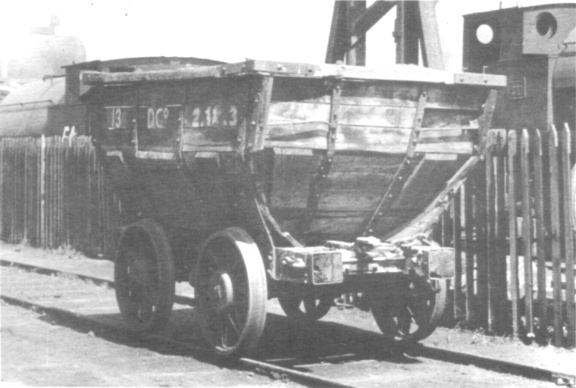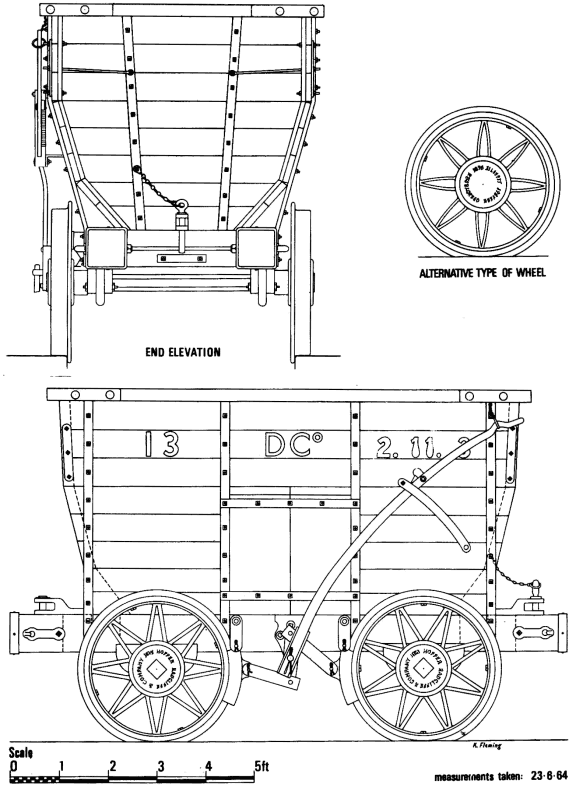
| THE INDUSTRIAL RAILWAY RECORD |
© JUNE 1966 |
CHALDRON WAGONS AT
SEAHAM HARBOUR
K. FLEMING
The chaldron wagons at Seaham Harbour have always fascinated me, and when I called in July 1965 I took the opportunity of studying them closely. They are fundamentally the same as those in use on Tyneside in the 18th century, although the Seaham examples are rather more refined in design and more "modern" in construction.
The body of No.13 (which I measured up) is constructed of 7in by 1½in wooden planks, reinforced with iron "straps" 2¼in wide and 1in thick. There are no springs and the brake gear is fitted on one side only. (Incidentally, in the drawings I have shown the brake blocks in the "on" position but the brake-lever in the "off" position.) The couplings are different at each end, ensuring that only wagons with the brakegear on the same side can be coupled together. Bottom doors are fitted and the axles are hexagonal. The name of the manufacturer (I noted three) is cast on the wheel hubs; the wheels are changed between wagons indiscriminately.


It would seem that the Seaham Harbour wagons were obtained from Londonderry Collieries Ltd., judging by the "L" painted on the sides of some of them. Others have had "D Co." painted on, together with a number; the latter, invariably between 1 and 40, would seem to indicate that about forty were bought by the Seaham Harbour Dock Co. Ltd.
The list below shows those I noted at Seaham in July 1965, in addition to No.31 which is on display in Clapham Transport Museum in London.
| No.2 | (Tare weight: 2-9-1). | "Narrow pointed star" type of spokes. |
| No.5 | (Tare weight: 2-12-0). | "Narrow" spokes. |
| No.6 | (Tare weight: 2-12-8). | Formerly Londonderry
Collieries Ltd. No.1209. One wheel shows HOPPER RADCLIFF & COMPANY, FENCEHOUSES/VANE/1870 and another shows same maker with date 1869. "Wide pointed star" type of spokes. |
| No.13 | (Tare weight: 2-11-3). | The hubs were covered in grease; one reads HOPPER RADCLIFF & COMPANY followed by a date. |
| No.17 | (Tare weight: 2-12-2). | "Wide" spokes. |
| No.23 | (Tare weight: 2-9-0). | "Narrow" spokes. |
| No.24 | (Tare weight: 2-10-2). | Formerly Londonderry
Collieries Ltd. No.1323. "Wide" spokes. |
| No.26 | (Tare weight: 2-10-0). | Formerly Londonderry
Collieries Ltd. No.664. "Narrow" spokes. |
| No.28 | (Tare weight: 2-13-2). | "Narrow" spokes. |
| No.29 | (Tare weight: 2-14-3). | "Narrow" spokes. |
| No.31 | (Tare weight: 2-13-0). | The wheels are from four different manufacturers (three of them with "wide" spokes) coming from OWEN & DYSON, ROTHERHAM, 1879 V.L., NEILSON (or NELSON) BROTHERS & CO., DARLINGTON 18??, and HOPPER RADCLIFF, FENCE HOUSES, 1877. |
| No.34 | (Tare weight: 2-11-3) | "Narrow" spokes. |
|
The following wagons at Seaham in July 1965 carried only their Londonderry number. |
||
| No.349 | (Tare weight: 2-11-3). | "Narrow" spokes. |
| No.389 | (Tare weight: 2-17-2). | "Narrow" spokes. |
| No.541 | (Tare weight: 2-13-1). | "Narrow" spokes. |
| No.1069 | (Tare weight: 2-19-12). | "Narrow" spokes. |
| No.1205 | (Tare weight: 2-9-1). | "Narrow" spokes. |
| No.1641 | (Tare weight: 2-13-0). | "Wide" spokes. |
In spite of their age, these wagons find useful employment, mainly as "dustbins" for rubbish of all kinds. Indeed six were being repaired in a timberyard next to Seaham locomotive shed in July 1965!